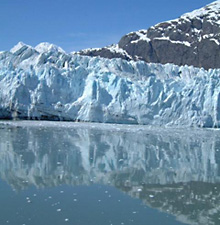
|
 |
 |
 Editorials | Environmental | January 2005 Editorials | Environmental | January 2005  
Alpinists' Ice-Dreamy Mountains Melting Away
 Katy Human - The Denver Post Katy Human - The Denver Post

Where there was once cold, hard ice, there is now dirty slush and crumbling rock. From the peaks and slopes of many of the world's most challenging mountains, ice and snow are dripping away, reshaping the century-old sport of alpinism and disquieting longtime mountain climbers.

 "Among alpinists who have been climbing for 20, 30 years, there is this sense of urgency that these climbs are going away," said John Bicknell, a guide, co-director of the Colorado Mountain School in Estes Park and a former geologist. "For me, it'll be an immense loss. It's where I've spent most of my life. It's the terrain I most love." "Among alpinists who have been climbing for 20, 30 years, there is this sense of urgency that these climbs are going away," said John Bicknell, a guide, co-director of the Colorado Mountain School in Estes Park and a former geologist. "For me, it'll be an immense loss. It's where I've spent most of my life. It's the terrain I most love."

Around the world, high-altitude regions are warming and melting. Kilimanjaro's glaciers have all but disappeared. Glacier National Park's are melting so fast that federal computer models predict they'll be gone by 2030.

Mark Dyurgerov, a University of Colorado glacier expert and former alpinist, calculated that the volume of the world's glaciers has dropped by about 10 percent in the past four decades. The decline is even faster in some places, he said, including the popular climbing meccas of Alaska, the Andes and the Alps.

Regardless of whether people, natural cycles or both are to blame, the effects are clear to climbers and guides. They're watching more rocks tumble down cliffs, throwing away useless old books and maps, and picking their way through miles of crumbly rock only to find climbs too dangerous to attempt.

"There are routes you cannot do anymore," said Jose Garcia, a Venezuelan who lives and works in Boulder and climbs around the world.

Three years ago, Garcia ventured into the ranges surrounding Piramide, a 19,000-foot-plus mountain in Peru. Avalanches constantly rumbled down the peak, loosened by warm temperatures and the changing structure of snow and ice hugging the mountain. "That used to be a very challenging, very interesting mountain," Garcia said. "You cannot climb it anymore. You can expect to die."

As glaciers draping the slopes of high mountains retreat, the ice moves, Garcia explained. Crevasses yawn wider and deeper, giant cliffs of ice called s้racs break away, and melting ice or permafrost loosens boulders, which tumble down slopes.

"Books are now obsolete," Garcia said. "Maps also."

When considering a climb, he checks the Internet for new route descriptions and pictures, or he contacts colleagues who have been there recently.

Although mountain climbers are often labeled as risk-takers, most say the new risks do not make climbing more fun.

"Climbers seldom look for dangerous routes," said Gary Neptune, owner of Neptune Mountaineering in Boulder and a lifetime alpinist. "Challenging, yes, but minimizing danger, that's part of the game."

Climbing in Africa several years ago, he and his colleagues searched for a glacier - the known access route to a peak in the Rwenzori Mountains. It had disappeared sometime in the past 30 years - the age of the photographs in his guidebook, Neptune said.

He and his colleagues abandoned the climb. "It's all getting less predictable or more extreme," Neptune said.

In the Alps, paths to some peaks have morphed from smooth glacial hikes into dangerous scrambles up rock- strewn slopes. Grosses Wiesbachhorn - the pitch in Austria where alpinists first used ice pitons in the 1920s - hasn't been icy in years, Neptune said.

A few decades ago, Boulder climber and guide Bob Culp loved to practice ice climbing at the foot of a glacier coming off France's Mont Blanc. He took his son there a few years ago, he said, but the trail to the glacier was closed. The two took another route to the glacier's edge.

"While we were standing there looking, a baseball-sized rock came tumbling down and hit me in the hip," Culp said. "I wasn't hurt, but I thought, 'This is not a place we want to be right now."' | 
 | |
 |



